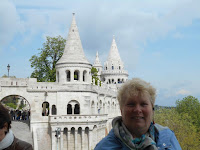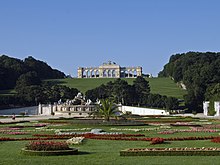Our tour today consisted of getting to know Budapest bus tour in the morning and a spa day in the afternoon which we were quite looking forward to. The weather was actually quite cool and overcast , a little breezy too but that was ok as we were in Budapest!
Our bus tour started with some history
Wikipedia says - "Budapest is the capital and the most populous city of Hungary, and the tenth largest city in the European Union by population within city limits. The city has an estimated population of 1,752,286 over a land area of about 525 square kilometres (203 square miles). Budapest is both a city and county, and forms the centre of the Budapest metropolitan area, which has an area of 7,626 square kilometres (2,944 square miles) and a population of 3,303,786, comprising 33% of the population of Hungary.
 The history of Budapest began when an early Celtic settlement transformed into the Roman town of Aquincum, the capital of Lower Pannonia.The Romans constructed roads, amphitheaters, baths and houses with heated floors in this fortified military camp. The Roman city of Aquincum is the best-conserved of the Roman sites in Hungary. The archaeological site was turned into a museum with inside and open-air sections.
The history of Budapest began when an early Celtic settlement transformed into the Roman town of Aquincum, the capital of Lower Pannonia.The Romans constructed roads, amphitheaters, baths and houses with heated floors in this fortified military camp. The Roman city of Aquincum is the best-conserved of the Roman sites in Hungary. The archaeological site was turned into a museum with inside and open-air sections. We were actually slated to go to an old Roman bath in the afternoon.
The Hungarians arrived in the territory in the late 9th century. The area was pillaged by the Mongols in 1241. Buda, the settlements on the west bank of the river, became one of the centres of Renaissance humanist culture by the 15th century. The Battle of Mohacs, in 1526, was followed by nearly 150 years of Ottoman rule. After the reconquest of Buda in 1686, the region entered a new age of prosperity. Pest-Buda became a global city with the unification of Buda, Obuda, and Pest on 17 November 1873, with the name 'Budapest' given to the new capital. Budapest also became the co-capital of the Austro-Hungarian Empire, a great power that dissolved in 1918, following World War 1. The city was the focal point of the Hungarian Revolution of 1848, the Battle of Buapest in 1945, and the Hungarian Revolution of 1956.
We were told a lot about the communist regime and how the people hated the communists and worked against them at every opportunity. There were some lovely buildings and a very old jewish temple which had not been destroyed during the war.
We then went to the Heros Square.
It is a very large square with lots of statues of all the rulers of Budapest over the ages. Turks, Ottoman. Heroes' Square is dominated by the Millenary Monument, with the Tomb of the Unknown Soldier in front. To the sides are the Museum of fine Arts and the Kunsthalle Budapest, and behind City Park opens out, with Vajdahunyad Castle.
We stayed here for a while taking photos and looking at all the statues. the wind had picked up and so we were chilly.
Once we drove around the hill and disembarked with clear instructions on what time to be back at the bus stop where they dropped us off at, we had to walk up a little hill to get to the walled city. The sun had come out but it was still a little breezy, all in all quite lovely. we walked through lots of little streets with lots of little shops, some of which we popped into to see what wares they had,
and there were little cars and bikes too. there were great views and then the main reason we came here, the seven-hundred-year-old Matthias Church which is one of the jewels of Budapest.
It is in neo-Gothic style, decorated with coloured shingles and elegant pinnacles. there was a statue St Mathias all shop full of arrows outside the church and next to it is an equestrian statue of the first king of Hungary, King Saint Stephen, and behind that was the Fisherman's Bastion, built in 1905.
It was spectacular.
Margie and I both loved the Fishermans Bastion. We took lots of photos here and also bought some table cloths from an old gypsy woman for 10 dollars each.
 The Fishermen's Bastions owes its name to the namesake corporation that during the Middle Ages was responsible of the defence of this part of ramparts, from where opens out a panoramic view of the whole city. Statues of the Turul, the mythical guardian bird of Hungary, can be found in both the Castle DistrictThere are three churches here, six museums, and a host of interesting buildings, streets and squares. Before we left I sprinkled Mom and Dad in a quite little park overlooking the city.
The Fishermen's Bastions owes its name to the namesake corporation that during the Middle Ages was responsible of the defence of this part of ramparts, from where opens out a panoramic view of the whole city. Statues of the Turul, the mythical guardian bird of Hungary, can be found in both the Castle DistrictThere are three churches here, six museums, and a host of interesting buildings, streets and squares. Before we left I sprinkled Mom and Dad in a quite little park overlooking the city. After our tour of the city concluded we got back to our stateroom to find a spa package awaiting us. robes and towels in a lovely bag and after a quick bite to eat we were off again to the old roman natural hot springs bath.
 There were about 6 of us from the ship going to the spa and when we got there we were escorted in to some change rooms on the second floor where we were to leave our things and let the attendant know which rooms we had used. She would lock it up for us and down we went into the very busy pool area. The first pool we went into was not hot but not cold either, and it had a lazy river in it which neither Margie nor I had ever seen before. We loved just floating along in the warm water. There were not too many kids there which was nice and we spent a good 45 minutes in the first pool.
There were about 6 of us from the ship going to the spa and when we got there we were escorted in to some change rooms on the second floor where we were to leave our things and let the attendant know which rooms we had used. She would lock it up for us and down we went into the very busy pool area. The first pool we went into was not hot but not cold either, and it had a lazy river in it which neither Margie nor I had ever seen before. We loved just floating along in the warm water. There were not too many kids there which was nice and we spent a good 45 minutes in the first pool. We then decided to explore and try out some of the other pools. We were surprised to find out how many there were. There were three outside one with was very much cooler and one the was very much warmer, then we went inside where there were at least ten of different temperatures and sizes. some of the hotter hot tubs were pretty full but we tried quite a few of the different pools and ran into some of the other passengers from the ship who were doing he same thing as we were.
We then decided to explore and try out some of the other pools. We were surprised to find out how many there were. There were three outside one with was very much cooler and one the was very much warmer, then we went inside where there were at least ten of different temperatures and sizes. some of the hotter hot tubs were pretty full but we tried quite a few of the different pools and ran into some of the other passengers from the ship who were doing he same thing as we were.Our time came to and end and after finding our change rooms and the attendant and paying her for watching our things we went to the small gift shop. Margie loaned me the money to buy a souvenir towel in a pretty turquoise with the spa picture and name in Hungarian embroidered on it.
Back on the bus and dinner for us. We were both really tired but the evening had warmed up and I wanted to go for a walk along the river and see the chain bridge and parliament buildings at night. Margie opted to stay and relax as her hip was really bothering her so I went alone.
 I am so glad I went. it was gorgeous. There were lots of people out waking along both sides of the river. I crossed the chain bridge with its magnificent lion statues guarding the ends and saw the funicular that was just on the other side of the river all lit up and very pretty. Maybe we would use it the next day in our wanders around town.
I am so glad I went. it was gorgeous. There were lots of people out waking along both sides of the river. I crossed the chain bridge with its magnificent lion statues guarding the ends and saw the funicular that was just on the other side of the river all lit up and very pretty. Maybe we would use it the next day in our wanders around town. I wandered down across from the parliament buildings. What a spectacular sight, like a fairy tale palace all lit up with soft yellow lights reflecting o the Danube river. I walked for about a half a hour out and the turned around as I too was getting extremely tired.
Margie was sad she had nt one along once she saw my photos. Well I guess we will just have to come back.







































